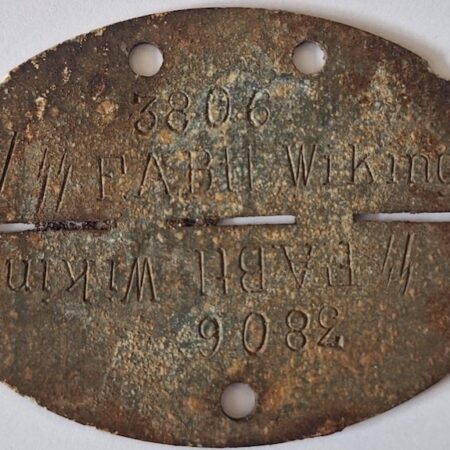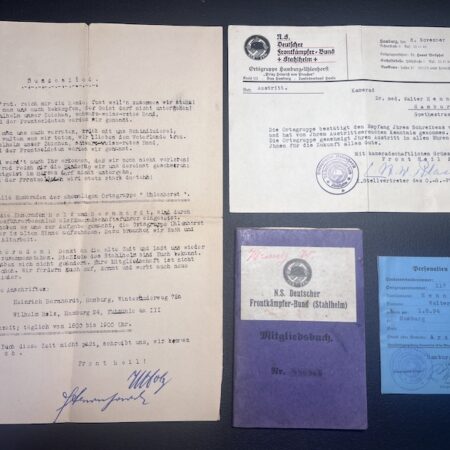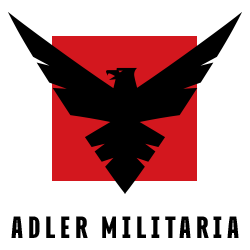- Sorry, this product cannot be purchased.
Showing 19–27 of 85 resultsSorted by latest
-

Original WWII German Wehrpass Leather Pouch
$65.00Here we have a Wehrpass Pouch Still closes although one side seems to be busted.
-

WWII German Waffen SS Dog Tag – Erkennungsmarke – SS Division Wiking – Found in Ground – Original
Really interesting, original Dog Tag for a member of the Feld Ausbildungs Batl of the the Wiking. Found in this year in the ground. Price includes Shipping World Wide
-

WWII German N.S Stahlhelm Bund Grouping – Dr Hennig -Hamburg – Rare Early ID Set!
$275.00Dr Walter Hennig born in 1894 in Hamburg. Served in WW1 as an Oberleutnant from 1914 till 1920! He was awarded the Following Awards: Iron Cross Second Class Iron Cross First Class Schaumburg-Lippe Cross The Hanseatic Cross KuK Military Cross Wounds Badge – Wounded Twice in WW1 He fought in France, Romania, Italy and Russia with the following unit: The Westfälisches Jäger-Bataillon Nr. 7 (7th Westphalian Jäger Battalion) of the Imperial German Army played a significant role in World War I, fighting on both the Eastern and Western Fronts. Initially part of the XX Army Corps, the battalion saw action at the Battle of Tannenberg on the Eastern Front before transferring to Italy and then the Western Front in 1918. The battalion was known for its elite status and experience in mountain warfare, having fought in various theaters including the Vogesen, Alps, and Karpathans. Here’s a more detailed look at the battalion’s involvement in WWI: Formation and Early Service: The battalion was formed in 1815 and saw action in the Franco-Prussian War and other conflicts before WWI. In 1914, it was garrisoned at Ortelsburg (modern Szczytno, Poland) and was part of the XX Army Corps. Eastern Front: The battalion initially served on the Eastern Front, including notable engagements like the Battle of Tannenberg. Shifting Fronts: In 1917, the battalion was transferred to Italy, and in the spring of 1918, it was moved to the Western Front. Elite Status and Training: Jäger battalions were considered elite units within the German Army, known for their training and experience in mountain warfare and raiding tactics. They were often used as assault troops and to revitalize sectors occupied by older troops. Distinctive Features: The 7th Jäger Battalion, like other Jäger units, was typically commanded by younger officers compared to their infantry counterparts. In 1932 he joined the NS Stahlhelm Bund, with Sturm 22 as the Doctor he left the NS Stahlhelm Bund in 1935. The documents are unique, as finding any higher ranks for the Stahlhelm Bund is nearly impossible, the books are usually nearly empty or have no photo. In this case, there is the NS Deutscher Frontkämpfer Bund ID with Uniformed picture.
-

Original WWII German General Gause Photo Album – Rommel Inspection Denmark 1943 – Sabotage Troops – Atlantic Wall – Hanstholm – Very Rare Images
$5,130.00Extremely Rare Images of Rommel In Denmark Taken By General Gause.
-

WWII German Kriegsmarine “Funktagebuch” Daily Radio Dairy – U-Boat / Destroyer – Rare
$275.00A Funktagebuch (“radio logbook” in German) was a crucial document used onboard German naval vessels and U-boats during World War II. It played an essential role in recording all radio communications and associated activities, which were critical for operational security, coordination, and post-mission analysis. Purpose of the Funktagebuch: Record of Communications: All incoming and outgoing radio messages (Funkverkehr) were logged, including: Encrypted messages (Enigma) Plaintext communications Orders from high command (e.g., Befehl von BdU – “Order from U-boat Command”) Contact reports, weather reports, and distress signals Technical Logging: Times of transmission and reception (in 24-hour UTC/GMT format) Frequencies and call signs used Message identification numbers Signal strength and reception quality Security and Accountability: Ensured that messages were properly received, decoded, and acknowledged Served as an official record in case of investigation or loss of vessel Could be reviewed by Kriegsmarine command (BdU – Befehlshaber der U-Boote) for performance and procedural compliance
-

WWII German Notice Normandy – Feldkommandantur 723 Caen France – Rare
$385.00This is a bilingual German-French WWII-era notice framed under glass, issued by the German military authority in occupied France. Specifically, it comes from Feldkommandantur 723, based in Caen, Normandy. These types of notices were typically used by the German occupation forces to issue rules or proclamations to the local population during the German occupation of France. German Text (Left Side): FELDKOMMANDANTUR 723 CAEN BEKANNTMACHUNG Beschlagnahme und Wegführen der Materialien, Geräte und Einrichtungen der Strassen- und Wasserbauverwaltung sowie der für diese Verwaltung arbeitenden Unternehmer ist Streng Verboten. Der Feldkommandant. (Signature)Oberstleutnant u. Kommandant French Text (Right Side): COMMANDEMENT TERRITORIAL 723 CAEN AVIS Il est formellement interdit d’enlever les matériaux, le matériel et les installations de l’Administration des Ponts et Chaussées et de ses Entrepreneurs. Le Commandant territorial. (Signature)Oberstleutnant u. Kommandant English Translation: TERRITORIAL COMMAND 723 – CAEN NOTICE The confiscation and removal of materials, equipment, and installations belonging to the Roads and Waterways Administration, as well as those used by contractors working for this administration, is strictly prohibited. The Field Commander / Territorial CommanderLieutenant Colonel and Commander
-

WWII German Waffen SS Pocket Diary SS Soldatenfreund 1944 -SS Unterscharführer Spitzhüttl – SS Panzergrenadier Regiment 20 – 9th SS Panzer Division “Hohenstaufen” – (RESERVED)
SS Soldatenfreund 1944 Owned by SS Unterscharführer Spitzhüttl According to his address, he was living in Sudetenland (Czech Republic) and was of German decent. His Feldpost Number is: 25405 C Stab II u. 5.-8. Kompanie Panzergrenadier-Regiment 20 (9. SS-Division) In October 1943, the regiment was renamed SS Panzergrenadier Regiment 20. In April 1944, the first battle took place near Tarnopol. On July 23, SS Panzergrenadier Regiments 19 and 20 suffered heavy losses and merged to form SS Panzerergrenadier Regiment “H.” On September 27, 1944, the regiment, together with SS Panzerergrenadier Regiment 19, the only half-strength Panzer Reconnaissance Battalion 9, the Divisional Escort Company of the 9th SS Panzer Division, SS Flak Battalion 9, elements of SS Pioneer Battalion 9, and a motorized artillery platoon, formed Kampfgruppe “Harzer,” led by SS Obersturmbannführer Walther Harzer. The KG’s troop strength was approximately 3,500 men. In November, the regiment was replenished and prepared for the Battle of the Bulge. On May 1, 1945, the regiment surrendered to US troops near Steyr along with the remnants of the division. More information: After the encirclement of General Hans-Valentin Hube’s 1st Panzer Army in the Kamenets-Podolsky pocket in Ukraine, Field Marshal Erich von Manstein requested that the Hohenstaufen and Frundsberg divisions be sent to attempt to link up with the encircled force. Arriving in late March 1944, the divisions were formed into the II SS Panzer Corps and were sent into the attack near the town of Tarnopol. In three days of combat, the Hohenstaufen destroyed 74 Soviet tanks, 84 self propelled assault guns, 21 anti tank guns, and 12 mortars. After heavy fighting in the season of rasputitsa (“roadlessness”), the division effected a link-up with Hube’s forces near the town of Buchach. The division’s actions helped prevent the encirclement of the 1st Panzer Army.[9] During these battles, Hohenstaufen had suffered 1,011 casualties. The II SS Panzer Corps was to act as reserve for Army Group North Ukraine. After the Allied invasion of northern France on 6 June 1944, the II SS Panzer Corps, including Hohenstaufen, was sent west on 12 June, to defend Caen in Normandy. Normandy Hohenstaufen suffered losses from Allied fighter bombers during its move to Normandy, delaying its arrival until 26 June 1944. Approximately 50% of the division’s tanks broke down during its movement to Normandy. The division’s armored forces would be reinforced by the newly attached 102nd SS Heavy Panzer Battalion. This would provide Hohenstaufen with 127 additional combat vehicles including 79 Panther tanks. The original plan for Hohenstaufen to attack towards the Allied beachhead was made impossible by a British offensive to take Caen. The II SS Panzer Corps was instead put into the line to support the weakened forces defending Caen, where Hohenstaufen suffered 1,891 casualties. On 10 July, the division was pulled back into reserve, to be replaced by the 277th Infantry Division. The division’s depleted Panzergrenadier regiments were eventually merged to form Panzergrenadier Regiment Hohenstaufen. The division saw much action defending against British armour during Operation Goodwood. During Operation Jupiter Hohenstaufen destroyed 58 British tanks with many of them being Churchill tanks. What we know from the entries, is that he was in Ukraine and in the battles, he earned a Panzer Badge in Bronze. It would also seem that he has made it out of there and by mid July is in France. Entries: there are scattered entries and notes taken the most interesting: Tactical Signs Journeys – naming every town/city and times he passed them. Award Entry – Panzerkampf Abzeichen – Panzer Badge in Bronze – 19.May.1944 Postal Record – Interestingly, he was recording when and from whom he was receiving post. With many entires in June 1944. Notes about places he was in 1943 till being sent to Lviv, Ukraine. Group Structure – Very detailed is the make up of the certain groups in the Company, this includes the names and dates. Basis for great research project. These entries shown in mid July 1944! Condition: Used, worn, and been there. It is in generally stable condition, with the map still inside, many have the maps missing. Final Comments: An interesting diary, with the potential for more research. Time could be invested into researching the individual soldiers. These are really rare with entries especially. It is unknown what happened to Spitzhüttl, it seems he is not on the VB Database as KIA and not on the Red Cross Missing Lists. He was most likely captured in France in the summer of 1944. Price includes World Wide Shipping!
-

WWII German Army Soldbuch – Feldwebel Hösch – Gebirgs-Jäger-Regiment 99 –
Soldbuch belonging to Feldwebel, (First Sergeant), Georg Hösch, born on February 6, 1920 in the small German town of Weinstadt. Soldbuch discharged on January 31, 1944, but it’s a duplicate, “Zweitschrift”, because on page 9, on vaccines, and on page 19, there’re records from 1941/42. Unfortunately, it’s unknown in what units he served during that time, if he was injured or suffered any illness. On January 31, 1944 he was assigned to Gebirgs-Jäger-Regiment 99, mountain hunter regiment, attached to the 1 Gebirgs-Division, which at that time, was in Bosnia and Croatia, fighting against partisan troops of the Marshal Tito. During these fighting, the 1- Gerbirgs Division was accused of war crimes, of burning several villages, and killing civilians. In March 1944, the regiment was sent to Hungary as reinforcement to the German troops that were there, to prevent the Hungarian government from capitulating or negotiating peace with the Soviets. When Hungary fell to Russian troops, the GJR-99 was sent to Greece as an anti- partisan force. In July of that year, again, these soldiers committed the same excesses they had committed in Bosnia, burning villages, killing civilians and stealing cattle, in the policy of “burned land”. After the fall of Greece, the regiment was sent to Montenegro, to face again the forces of Tito. On September 13, 1944, this Feldwebel was assigned to Grenadier Regiment 893, attached to the 264 Inf Div, which at that time was fighting in Belgrade and northern Serbia, next to the 118 Jäger Division, fighting, first against the Yugoslav partisans and then against the Soviet troops. In October the 2 divisions defended the Zara – Benkovac – Biograd line, but little by little they retreated through Drnis, Knin, Biha and Agram, suffering terrible casualties due to heavy artillery and Soviet bombers. On November 15, the 264-ID, together with the 373 Infanterie Division, (Croatian), fought in the defense of the Podkonje-Ocestovo line. But the Croatian division gradually decomposed, between casualties and desertions, exposing the right flank of the 264-ID. Finally, the German division, to avoid being surrounded, had to retreat north from Belgrade. In December 1944, the division suffered significant casualties, including the destruction of IBataillon / Grenadier Regiment 893, after having been surrounded near the town of Ruma. In the middle of the month, part of the division, which included units of the 891 and 892 regiments, almost the entire artillery regiment, communications, intendancy and supplies units, and the remains of the 373 Croatian division, were surrounded on the eastern shore of the Danube river, where they were destroyed by soviet heavy artillery and tanks. Both divisions suffered 4800 casualties, among dead, wounded, missing and captured; only about 500 soldiers managed to cross the river and contact the rest of the division. In early January 1945, the remains of the 264-ID forming a kampfgruppe, established a weak defensive position on the Bihac-Medak line, where they were supported by the also decimated 392 Infanterie Division, (Croatian). At the end of January, the division was removed from the front to be reorganized, and to receive replacements of just 17 years, without combative capacity. In March 1945, (in the soldbuch the exact date is not specified), this sergeant was assigned to the Jäger Regiment 21 der Luftwaffe, attached to the 11. Feld-Division (L), field division of the Luftwaffe, which by that then fought in Croatia and Serbia, along with some units of the Ustacha, the Croatian fascist militia. At the end of the month, the Luftwaffe division, attached to the LXXXXI Armeekorps, was very decimated, without receiving replacements, and with a few pieces of artillery, defended a broad front of almost 75 km. Between the Cepin-Bizovac- Valpovo-Marijanci line. In early April, a combined attack by Tito partisans and Soviet troops, supported by heavy artillery and tanks T-34 and KV-Il, broke the entire front. The sector of the 11. Feld-Division (L), at first remained calm, but the disarray of the 5th Croatian Division, exposed the right flank of the division, and initiated the withdrawal towards Nasice, Bukovica and Cancinci. In May, finally, the division surrendered to the Soviet troops, refusing to surrender to the partisan troops of Tito. Soldbuch with numerous records: material delivery, (among them, an MP40 automatic submachine gun and a Walther P38 pistol, vaccines, etc. Pages 21/24 are missing, for which the number of awards and / or permits it’s unknown. In the photograph of the cover, in the left pocket of the jacket, there is a pin of three medals, which seem to correspond to: 1) Iron Cross 2nd class, “Eiserne Kreuz 2 Klasse 2) Russian Campaing Medal 1941/42 , “Winterschlacht im Osten 1941/42, Ostmedaille” 3) Wehrmacht Long Service Medal 4th Class , “Wehrmacht-Dienstauszeichnung , 4 “
-

WWII Wehrmacht Soldbuch – Oberschirrmeister Krzisinski – KIA Rhine Crossing March 1945 – US 45th “Thunderbird” Infantry Division – Gernsheim, Germany – Rare
$575.00This is a rather interesting Soldbuch, issued to Krzisinski in 1943, when serving with the Pioneer Batl 134. The unit served under the 134 Infanterie Division From June 1941, the 134th Infantry Division took part in the invasion of the Soviet Union as part of the Army Group Center. In December 1941, the division was involved in the Battle of Moscow. Together with the 45th Infantry Division, she was temporarily surrounded as part of the 2nd Army at Livny and lost a large part of her artillery. The division was destroyed in the Soviet Bobruysk Offensive, part of Operation Bagration in the summer of 1944. Krzisinski arrived at the Hospital in August of 1944, with a wound code 34, meaning an accident. He was awarded the Eastern Front Medal and the War Merit Cross with Swords. March 1945 The very nice late war ID permit for the area he was allowed to travel in was key in understanding where he was in the last days. With the Pioneer Ausbildungs Batl 837 in Gernsheim on the Rhine River. He is mentioned on a Memorial next to the graveyard, where he is buried beside. His brother was KIA, What happened on the 26th of March 1945 in Gernsheim? On the 26th of arch 1945, the 179th Infantry Regiment “Tomahawks” of the 45th “Thunderbird” Infantry Division crossing of the Rhine River on March 26, 1945 as part of the US 7th Army attack to breech the river. The Germans fell back destroying the bridge, which till today was never repaired and is left as a memorial to the horrors of war. A memorial to the US Soldiers can be found next to it and they have a breif synopsis of the the attack across the Rhine. https://www.uswarmemorials.org/html/monument_details.php?SiteID=2207&MemID=2908 When studying the KIA lists for the Town in March of 1945, it is clear that the only German Soldiers killed defending the town were all Pionner/Sappers. A handful of Germans were killed there, including a list of Civilians caught in the Artillery strikes in Gernsheim. List can be found here: http://www.denkmalprojekt.org/dkm_deutschland/gernsheim_wk1u2_hess.htm Here is the combat diary of the 179th Inf Regiment Us Army, they mention in depth the attack on Gernsheim. https://worldwartwoveterans.org/wp-content/uploads/2022/01/The-story-of-a-regiment-a-history-of-the-179th-Regimental-Combat.pdf US Hero at Gernsheim on the Attack ! http://veterantributes.org/TributeDetail.php?recordID=1571




